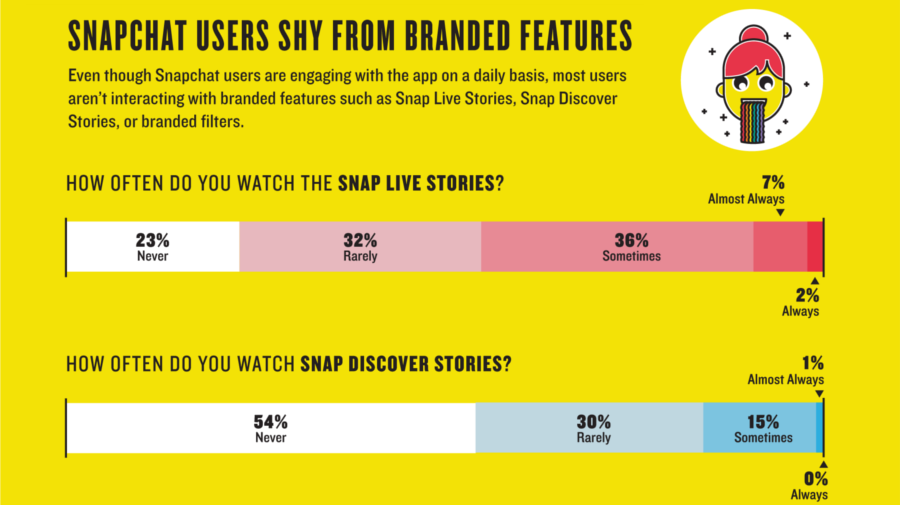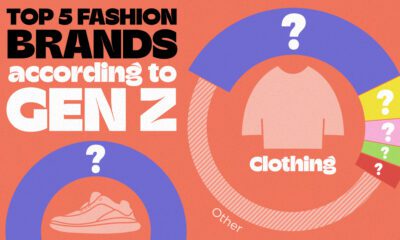Technology
The Snapchat Monetization Problem
There’s no doubt that messaging app Snapchat is on the brink of something huge.
The user metrics continue to impress, and the app just recently passed Twitter with 150 million daily active users. Snapchat has also vaulted past Instagram in time spent by users, making it the second-most used app by iPhone users, trailing only Facebook.
With a median user age of 18, Snapchat’s business premise is that it allows marketers to tap into the mysterious Millennial and Gen Z audiences that continue to perplex many brands. However, the jury is out on whether the app is delivering on this promise.
There’s now more than $2.65 billion of venture capital at stake that depends on solving the Snapchat monetization problem.
The Snapchat Monetization Problem
Today’s infographic shows the results from a survey of Snapchat users by NewsCred, a content marketing platform. The data paints a picture of Snapchat as an app that engages users, while whiffing on the branded content it needs to generate revenue.

Courtesy of: NewsCred
In other words, if Snapchat is counting on advertising as its main monetization driver, it is going to need to get more users engaging with branded content. Then, Snapchat must able to prove that to advertisers through targeting, analytics, and other useful metrics.
Snapchat is Getting Serious
In the first half of 2016, Snapchat raised $1.8 billion in its Series F round at a flat valuation of $16 billion.
This says two things.
First, with an estimated $59 million in revenue in 2015, investors are worried about the Snapchat monetization problem. Otherwise, the company’s valuation would have risen from the previous Series E which took place over a year prior.
Second, this war chest of new capital is going to be used to pounce on revenue opportunities, as well as providing better analytics to advertisers.
To the latter point, Snapchat is now making major moves to deliver on the revenue front. The company recently poached a key ad exec from Facebook. The app also launched a revamped Snapchat Discover portal that allows major publishers like Cosmopolitan or BuzzFeed to get in on the action to share ad revenue. Snapchat is also finally getting serious about metrics, and that’s why the company signed with Nielsen to start measuring the performance of ads like a television network would.
Will Snapchat’s revenues ever measure up to its user growth and marketing promise to advertisers? For now, the Snapchat monetization challenge remains, and investors are divided on the company’s future prospects.
Technology
Ranked: Semiconductor Companies by Industry Revenue Share
Nvidia is coming for Intel’s crown. Samsung is losing ground. AI is transforming the space. We break down revenue for semiconductor companies.
Semiconductor Companies by Industry Revenue Share
This was originally posted on our Voronoi app. Download the app for free on Apple or Android and discover incredible data-driven charts from a variety of trusted sources.
Did you know that some computer chips are now retailing for the price of a new BMW?
As computers invade nearly every sphere of life, so too have the chips that power them, raising the revenues of the businesses dedicated to designing them.
But how did various chipmakers measure against each other last year?
We rank the biggest semiconductor companies by their percentage share of the industry’s revenues in 2023, using data from Omdia research.
Which Chip Company Made the Most Money in 2023?
Market leader and industry-defining veteran Intel still holds the crown for the most revenue in the sector, crossing $50 billion in 2023, or 10% of the broader industry’s topline.
All is not well at Intel, however, with the company’s stock price down over 20% year-to-date after it revealed billion-dollar losses in its foundry business.
| Rank | Company | 2023 Revenue | % of Industry Revenue |
|---|---|---|---|
| 1 | Intel | $51B | 9.4% |
| 2 | NVIDIA | $49B | 9.0% |
| 3 | Samsung Electronics | $44B | 8.1% |
| 4 | Qualcomm | $31B | 5.7% |
| 5 | Broadcom | $28B | 5.2% |
| 6 | SK Hynix | $24B | 4.4% |
| 7 | AMD | $22B | 4.1% |
| 8 | Apple | $19B | 3.4% |
| 9 | Infineon Tech | $17B | 3.2% |
| 10 | STMicroelectronics | $17B | 3.2% |
| 11 | Texas Instruments | $17B | 3.1% |
| 12 | Micron Technology | $16B | 2.9% |
| 13 | MediaTek | $14B | 2.6% |
| 14 | NXP | $13B | 2.4% |
| 15 | Analog Devices | $12B | 2.2% |
| 16 | Renesas Electronics Corporation | $11B | 1.9% |
| 17 | Sony Semiconductor Solutions Corporation | $10B | 1.9% |
| 18 | Microchip Technology | $8B | 1.5% |
| 19 | Onsemi | $8B | 1.4% |
| 20 | KIOXIA Corporation | $7B | 1.3% |
| N/A | Others | $126B | 23.2% |
| N/A | Total | $545B | 100% |
Note: Figures are rounded. Totals and percentages may not sum to 100.
Meanwhile, Nvidia is very close to overtaking Intel, after declaring $49 billion of topline revenue for 2023. This is more than double its 2022 revenue ($21 billion), increasing its share of industry revenues to 9%.
Nvidia’s meteoric rise has gotten a huge thumbs-up from investors. It became a trillion dollar stock last year, and broke the single-day gain record for market capitalization this year.
Other chipmakers haven’t been as successful. Out of the top 20 semiconductor companies by revenue, 12 did not match their 2022 revenues, including big names like Intel, Samsung, and AMD.
The Many Different Types of Chipmakers
All of these companies may belong to the same industry, but they don’t focus on the same niche.
According to Investopedia, there are four major types of chips, depending on their functionality: microprocessors, memory chips, standard chips, and complex systems on a chip.
Nvidia’s core business was once GPUs for computers (graphics processing units), but in recent years this has drastically shifted towards microprocessors for analytics and AI.
These specialized chips seem to be where the majority of growth is occurring within the sector. For example, companies that are largely in the memory segment—Samsung, SK Hynix, and Micron Technology—saw peak revenues in the mid-2010s.
-

 Misc2 weeks ago
Misc2 weeks agoTesla Is Once Again the World’s Best-Selling EV Company
-

 AI1 week ago
AI1 week agoThe Stock Performance of U.S. Chipmakers So Far in 2024
-

 Misc1 week ago
Misc1 week agoAlmost Every EV Stock is Down After Q1 2024
-

 Money1 week ago
Money1 week agoWhere Does One U.S. Tax Dollar Go?
-

 Green2 weeks ago
Green2 weeks agoRanked: Top Countries by Total Forest Loss Since 2001
-

 Real Estate2 weeks ago
Real Estate2 weeks agoVisualizing America’s Shortage of Affordable Homes
-

 Maps2 weeks ago
Maps2 weeks agoMapped: Average Wages Across Europe
-

 Mining2 weeks ago
Mining2 weeks agoCharted: The Value Gap Between the Gold Price and Gold Miners












